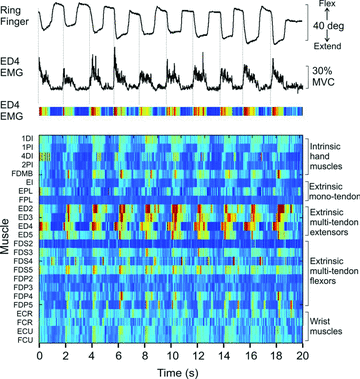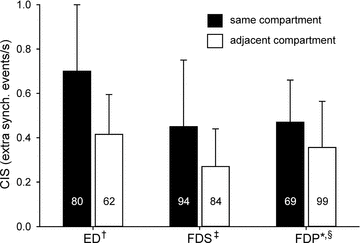Mechanical properties and neural control of human hand motor units
- PMID: 22005677
- PMCID: PMC3249035
- DOI: 10.1113/jphysiol.2011.215236
Mechanical properties and neural control of human hand motor units
Abstract
Motor units serve both as the mechanical apparatus and the final stage of neural processing through which motor behaviours are enacted. Therefore, knowledge about the contractile properties and organization of the neural inputs to motor units supplying finger muscles is essential for understanding the control strategies underlying the diverse motor functions of the human hand. In this brief review, basic contractile properties of motor units residing in human hand muscles are described. Hand motor units are not readily categorized into the classical physiological types as established in the cat gastrocnemius muscle. In addition, the distribution of descending synaptic inputs to motor nuclei supplying different hand muscles is outlined. Motor neurons innervating intrinsic muscles appear to have relatively independent lines of input from supraspinal centres whereas substantial divergence of descending input is seen across motor nuclei supplying extrinsic hand muscles. The functional significance of such differential organizations of descending inputs for the control of hand movements is discussed.
Figures





Similar articles
-
Common synaptic input across motor nuclei supplying intrinsic muscles involved in the precision grip.Exp Brain Res. 2008 Jun;188(1):159-64. doi: 10.1007/s00221-008-1432-7. Epub 2008 May 28. Exp Brain Res. 2008. PMID: 18506431 Free PMC article.
-
Synergistic Organization of Neural Inputs from Spinal Motor Neurons to Extrinsic and Intrinsic Hand Muscles.J Neurosci. 2021 Aug 11;41(32):6878-6891. doi: 10.1523/JNEUROSCI.0419-21.2021. Epub 2021 Jul 1. J Neurosci. 2021. PMID: 34210782 Free PMC article.
-
Motor-unit synchrony within and across compartments of the human flexor digitorum superficialis.J Neurophysiol. 2007 Jan;97(1):550-6. doi: 10.1152/jn.01071.2006. Epub 2006 Nov 8. J Neurophysiol. 2007. PMID: 17093112
-
The primate reticulospinal tract, hand function and functional recovery.J Physiol. 2011 Dec 1;589(Pt 23):5603-12. doi: 10.1113/jphysiol.2011.215160. Epub 2011 Aug 30. J Physiol. 2011. PMID: 21878519 Free PMC article. Review.
-
Human spinal cord injury: motor unit properties and behaviour.Acta Physiol (Oxf). 2014 Jan;210(1):5-19. doi: 10.1111/apha.12153. Epub 2013 Sep 13. Acta Physiol (Oxf). 2014. PMID: 23901835 Review.
Cited by
-
Flexibility of movement organization in piano performance.Front Hum Neurosci. 2013 Jul 16;7:173. doi: 10.3389/fnhum.2013.00173. eCollection 2013. Front Hum Neurosci. 2013. PMID: 23882199 Free PMC article.
-
Moving in on human motor cortex. Characterizing the relationship between body parts with non-rigid population response fields.PLoS Comput Biol. 2022 Apr 4;18(4):e1009955. doi: 10.1371/journal.pcbi.1009955. eCollection 2022 Apr. PLoS Comput Biol. 2022. PMID: 35377877 Free PMC article.
-
Circuits for grasping: spinal dI3 interneurons mediate cutaneous control of motor behavior.Neuron. 2013 Apr 10;78(1):191-204. doi: 10.1016/j.neuron.2013.02.007. Neuron. 2013. PMID: 23583114 Free PMC article.
-
Speed invariance of independent control of finger movements in pianists.J Neurophysiol. 2012 Oct;108(7):2060-8. doi: 10.1152/jn.00378.2012. Epub 2012 Jul 18. J Neurophysiol. 2012. PMID: 22815403 Free PMC article.
-
Common Motor Drive Triggers Response of Prime Movers When Two Fingers Simultaneously Respond to a Cue.Brain Sci. 2021 May 26;11(6):700. doi: 10.3390/brainsci11060700. Brain Sci. 2021. PMID: 34073345 Free PMC article.
References
-
- An KN, Hui FC, Morrey BF, Linscheid RL, Chao EY. Muscles across the elbow joint: a biomechanical analysis. J Biomech. 1981;14:659–669. - PubMed
-
- Bakels R, Kernell D. Average but not continuous speed match between motoneurons and muscle units of rat tibialis anterior. J Neurophysiol. 1993;70:1300–1306. - PubMed
-
- Bigland-Ritchie B, Fuglevand AJ, Thomas CK. Contractile properties of human motor units: is man a cat? Neuroscientist. 1998;4:240–249.
-
- Bromberg MB. Updating motor unit number estimation (MUNE) Clin Neurophysiol. 2007;118:1–8. - PubMed
Publication types
MeSH terms
Grants and funding
LinkOut - more resources
Full Text Sources
Miscellaneous

